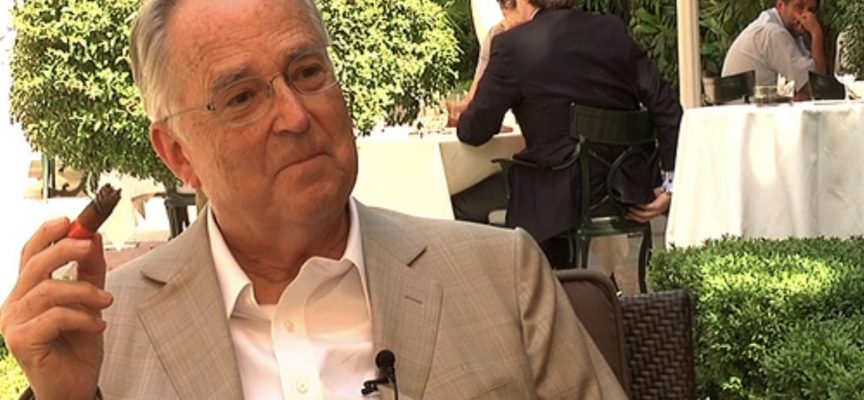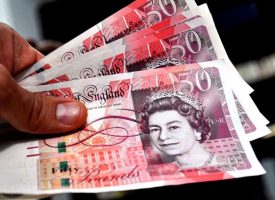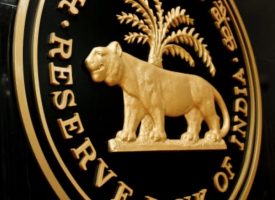With markets hitting new highs, today multi-billionaire Hugo Salinas Price discusses the Great Con, silver and the deterioration of society.
Silver
October 18 (King World News) – Multi-billionaire Hugo Salinas Price: “A well-known story from yesteryear: when Venustiano Carranza was President of Mexico (1917-1920). Carranza issued a great quantity of worthless paper money, which caused much resentment on the part of the population. Someone (whose identity was never discovered) printed up some papers, and these were pasted one night on the walls of buildings in the heart of Mexico City; the papers had the following text:
“The Mexican eagle is a very cruel animal: It eats only silver, and shits only paper.”
President Carranza was furious on account of the insult, and his government offered a reward of $5,000 Pesos for information leading to the arrest of the culprit…
IMPORTANT:
To hear which legend just spoke with KWN about $8,000 gold and the coming mania in the
gold, silver, and mining shares markets CLICK HERE OR ON THE IMAGE BELOW.
 Sponsored
Sponsored
The witty author answered with a new text pasted on the walls of downtown Mexico City during the following night:
“And with what is the payment to be? With what the eagle eats, or with what the eagle shits?
Another tale from the time of Carranza: one good day, one of the humble peasant women selling vegetables in the great “Merced” market of downtown Mexico City refused to receive payment for her vegetables in paper money. She demanded silver coin in payment. Her example was swiftly followed by the rest of the women selling foodstuffs at the market. I have no further information on what happened after that, but I suspect that this refusal to accept paper money led to the end of Don Venustiano’s paper money scheme. In 1920, he created the 0.720 Peso (i.e. 72% pure silver) which was the money that Mexico used up to 1945, when the coin could no longer be minted because the price of silver in the coin became worth more than $1 Peso.
I think it is interesting to know why the Mexican monetary unit is called the “Peso”. In 1535, the Mexican Mint in Mexico City began to mint silver coins that eventually became the most-used money in the world: the famous “Pieces of Eight”. (Under President Jefferson, the model of the Mexican “Pieces of Eight” was the model used for the US Silver Dollar.) After Mexican Independence, the “Pieces of Eight” minted under Spanish rule had to be modified in their facial characteristics, in accord with the new situation of independence from Spain. The world “peso” in Spanish, means “weight”. The new coin was called the “Peso”, because it contained the same weight of silver as its predecessor, the “Pieces of Eight”. This Mexican silver Peso continued to be the money of Mexico from 1812, shortly after Independence, up to the outbreak of the Mexican Revolution, in 1910. So the silver money established under Monarchy continued without change for nearly four centuries, from 1535 to 1910 – a notable case of monetary stability, perhaps only outdone by the gold Bezant of the Byzantine Empire.
Venustiano Carranza was assassinated in 1920: some historians claim that he was assassinated because his policy did not accommodate the interests of the US, whose aim was to put an end to the great productivity of Mexican agriculture, at the time in the hands of the great landowners of the country. Don Venustiano was opposed to the “Agrarian Reform” that the US wished to impose upon Mexico.
Perhaps the assassination of Don Venustiano also opened the way for the creation of a Central Bank in Mexico, which took place in 1925. Its organization was parallel to the creation of the Federal Reserve in 1913. We cannot know whether he would have favored the creation of a Central Bank, or not.
Up to 1925 there existed in Mexico private banks which were well-managed, as for example the Terrazas Bank in the State of Chihuahua in northern Mexico, whose banknotes enjoyed an unblemished reputation as representations of wealth – that is to say, their banknotes were fully redeemable in silver money upon presentation to the bank. However, there were also some private banks that were not well-managed by their owners, who used their banks to finance their own ventures, which sooner or later led to their bankruptcy, to the detriment of their depositors and creditors, among which were the owners of the banknotes they had issued as money.
The Great Con
One of the reasons given both for the creation of the Federal Reserve in 1913, and for the creation of Banco de Mexico in 1925, was that it was necessary to do away with “the bankruptcy of banks” – though the leaders of the move to create the Federal Reserve were the great bankers of the US, who wanted to create an entity that would protect them from their own mismanagement, by means of a guarantee of financial support of the Federal Reserve if and when they should run into a situation of insolvency.
The result of the “Guarantee” on the part of the Federal Reserve was that all the banks associated to the banking system under the control of the Federal Reserve immediately proceeded to operate imprudently: if one bank acted imprudently without any risk, it would have a competitive advantage over its rivals; therefore all were compelled to act imprudently or get left behind. The mismanagement consisted in “borrowing short and lending long”, in other words using funds obtained either “at sight” or for a short period of time from depositors and investors, and lending them out for a longer term, which was more profitable. The same result obtains at present, in the Mexican banking system.
Another reason given for the creation of a Central Bank in Mexico, was that the issue of banknotes would not be permitted to private banks, but would be a function enjoyed exclusively by the Central Bank, which would thus establish a sound and reliable monetary system in the country.
However, what was achieved was a situation which was much worse: instead of having to suffer the bankruptcy of some isolated banks of private property, the establishment of Banco de Mexico became an entity which would collaborate with the government in the government’s requirements of unlimited spending.
The interests of isolated cases of private banks whose mismanagement continued until they reached insolvency and bankruptcy, were substituted by a Federal entity, Banco de Mexico, which can never go bankrupt and whose banknotes and digital money must be unquestionably accepted in payment of debts, notwithstanding their continual depreciation.
Up until 1925, and practically since our Independence up to the present, with the exception of the revolutionary period (1910 – 1925) the Peso/Dollar ratio was always more or less $2 Pesos for $1 Dollar. Today, the Peso/Dollar ratio hovers around $19,000 Pesos for $1 Dollar – if we ignore the make-up applied to the Peso en 1993, when three zeros were erased from the ratio. And we all know that the Peso is in danger of falling to $20, to $23, to $25,000 or more – God only knows what is in store for the Banco de Mexico Peso!
To make matters worse, we have to take into account the fall in value of the Dollar itself, during the same period – for the same reason, excessive money printing or creation of excessive digital money. It has been calculated that the US Dollar is today worth only 3 Cents or less of its value in 1925.
The Deterioration Of Society
One highly important result of the monetary system we are forced to endure, has been the progressive moral deterioration of society in general, both in the Mexico and in the US – actually in the whole world.
The world’s thinkers turn a blind eye to the very strong link that exists between the prevailing morality in a nation and its monetary system. Honesty prevails where real money – of gold or silver – prevails. When a nation is forced to live with false money – paper or digital – honesty is compromised and vice booms; just one of the many symptoms of moral breakdown is the flight from a situation of uncertainty into the refuge of a drug-induced stupor, when how to act in order to provide for life becomes an unsolvable puzzle due to the forced use of false money. Apparently, the Catholic Church itself does not worry about false money. I once had a conversation with Cardinal Norberto Rivera, during which I suggested the support of the Church for my proposal regarding the silver “Libertad” ounce. Don Norberto yawned and said he knew nothing about monetary affairs.
I close with a last anecdote:
My father-in-law, Don Guillermo Pliego y Pliego, once told me of an experience he had: “I saw a truck in downtown Monterrey (Mexico) on its way to the refinery at American Smelting and Refining Company, loaded with 0.720 silver Pesos; the truck had a mishap and dumped its silver load into the street; hundreds of Pesos rolled down the street, but the people passing by gathered every one of them and returned them to the truck.”
Can we imagine how people would react, in a similar situation, today?
KWN has now released the remarkable audio interview with the man who counsels the biggest money on the planet, Michael Belkin, discussing world markets, the dollar, bonds, gold, silver and the fortunes to be made investing in mining shares CLICK HERE OR ON THE IMAGE BELOW.
***ALSO JUST RELEASED: A Look At The Cocaine High And How The Great Unwind Will Impact Gold, Silver And The Miners CLICK HERE.
© 2017 by King World News®. All Rights Reserved. This material may not be published, broadcast, rewritten, or redistributed. However, linking directly to the articles is permitted and encouraged.







